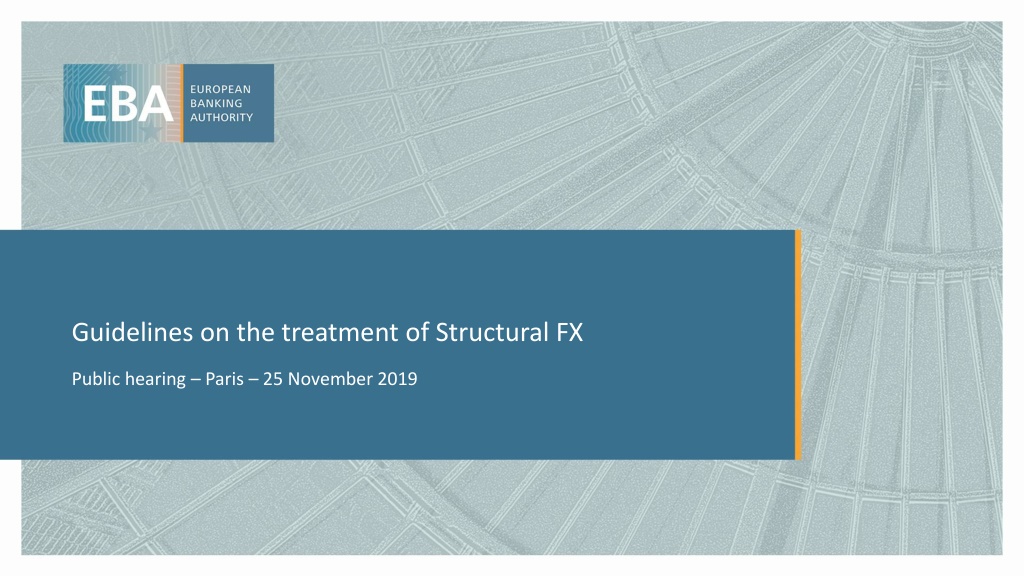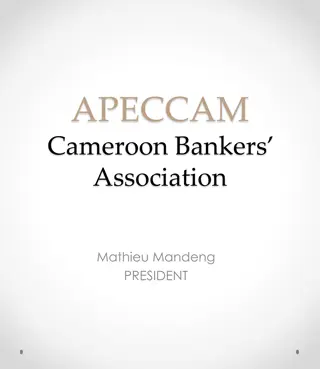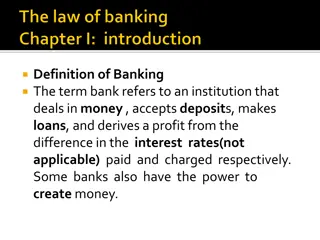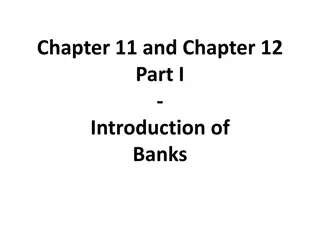Guidelines on Treatment of Structural FX Provision in Banking Sector
The guidelines focus on ensuring a harmonized interpretation and implementation of the structural FX provision in the Capital Requirements Regulation (CRR). It discusses the scope of applicability, provisions on currencies for which waivers are sought, and minimum requirements for positions to be considered for waivers. Institutions are asked to provide feedback on various elements such as the relevance of currencies, hedging practices, and exemptions at solo and consolidated levels.
Download Presentation

Please find below an Image/Link to download the presentation.
The content on the website is provided AS IS for your information and personal use only. It may not be sold, licensed, or shared on other websites without obtaining consent from the author. Download presentation by click this link. If you encounter any issues during the download, it is possible that the publisher has removed the file from their server.
E N D
Presentation Transcript
Guidelines on the treatment of Structural FX Public hearing Paris 25 November 2019
Introduction The guidelines (GLs) aim at ensuring an harmonized interpretation and implementation of the structural FX (S-FX) provision included in Article 352(2) of the CRR The EBA published a Discussion Paper (DP) in 2017 to gather feedback around the current stakeholder s practices while discussing several elements of the provision The overall framework envisaged in the guidelines is applicable both where institutions calculate the own funds requirements for market risk under the current framework and under the new FRTB requirements 1. Clarification on the scope of applicability Banks can apply for the S-FX waiver: 1. for any of the three capital ratios 2. both where using SA and IMA for capitalising their FX risk 3. both at solo and at consolidated level Q1. Would you consider beneficial to limit the S-FX provision to hedge the CET1 ratio aiming at creating a level playing field in the EU? Please provide a rationale. Q2. Which of the three ratios is your institution hedging? 2
2. Provisions on the currencies for which the institution seeks the waiver The waiver should be sought for positions in foreign currencies that are relevant for the business of the institution The three most material currencies (in terms of open positions) are identified as relevant Other currencies may be relevant the institution needs to provide a justification proving the relevance of the currency (e.g. cross-border nature of the business) The EBA acknowledges that the absolute threshold of 3 currencies may not capture the actual relevance of a currency in the business of the institution and seeks feedback (see Q3 and Q4 of the CP) on other possible measures that could be used alternatively to such absolute threshold: Measure A: percentage of the open position in the foreign currency (without considering any waiver) with respect to the open position in the reporting currency. Measure B: percentage of the open position in the foreign currency (without considering any waiver) with respect to the total own funds of the institution. 3
3. Identification of minimum requirements for a position to be considered for the waiver 3a. Minimum requirements for a position to be considered of a structural nature Only Banking Book (BB) positions can be considered to have a structural nature 3b. Minimum requirements to be considered to hedge the ratio The conditions identified in the guidelines ensure that the numerator of the ratio moves in the same direction of the denominator when the FX changes: The ratio moves up when the foreign-currency appreciates At solo level: the position for which the exemption is sought has to be long At consolidated level (see paragraph 25 of the GLs): Without any permission to offsetting positions among institutions in the group (see article 325): the position for which the exemption is sought has to be net long at the level of each institution in the group With the permission to offset some (or all) positions among institutions in the group (see article 325): the position has to be long at the level at which the net open positions are calculated for getting the own funds requirements for market risk (which are then summed up via summation approach) Q5: Do you agree with the policy included in paragraph 25? Please elaborate. 4
4. Assessment of the structural nature of a position The GLs identify positions (called positions of type A) for which there is the presumption (i.e. no automaticity) of their structural nature: At solo level positions corresponding to investments in subsidiaries At consolidated level: both of the following conditions need to be met: a) b) The position stems from a subsidiary The currency of the position coincides with the reporting currency used by the subsidiary holding the item to which such position corresponds Other positions (called positions of type B) may be identified as structural however no presumption is recognised in the guidelines Q6. Are the structural positions for which you plan to ask the permission mainly positions of type A (i.e. meeting the condition in the paragraph above), or positions of type B? 5
5. Assessment of the intention to hedge the ratio (1) The guidelines identify several qualitative requirements aiming at assessing the intention of the institution to hedge the ratio. For example the risk management framework of S-FX positions: (i) Should outline the definition of the boundaries between positions that the institution categorises as structural and taken with the purpose of hedging the ratio and those that are not, and should require that such boundaries are used by the institution where taking a new position in the relevant currency; (ii) Should state the positions the institution intends to open or close for keeping the sensitivity of the ratio to changes in the exchange rate stable over time; (iii) Should be consistent with the overall risk-management of the institution (iv) Should be consistent with the risk-management framework of S-FX positions at another level of consolidation (where applicable) (v) Should define a strategy for keeping the sensitivity stable over time that has a time horizon of at least six months 6
5. Assessment of the intention to hedge the ratio (2) In terms of quantitative requirements, institutions are required to keep ??????????? within ????? over time: ??????????? =?_?? ????? ???????_?? ????e = [ ?????? 0.05 ?_??????????? ; ?????? +0.05 ?_??????????? ?????????????????? ] ?????????????????? ??????????? has been obtained by first determining an approximation of the sensitivity of the ratio to changes in the exchange rate, and by then removing from the first term in the numerator the effect of positions that cannot be exempted (e.g. TB positions). Q8. Do you agree with the exclusion of positions that are not eligible to be structural from the sensitivity that is used for assessing the intention of the institution to hedge the ratio, or would you prefer to have those positions included although they cannot be exempted? Please elaborate. Q10. Do you think that by excluding positions that are non-eligible to be exempted, it will be easier for institutions to meet the requirement of keeping the sensitivity stable over time? Please elaborate. Q12. Do you agree with the definition of the range? Do you think that 0.05 is an appropriate value? Q9. Are there currently FX-risk positions that you kept open in the trading book for the purpose of hedging the ratio? Why did you not include such positions as part of the banking book since the main purpose of those positions is to hedge the ratio?
6. Size of the open position to be excluded and on-going monitoring (1) The guidelines provide the formula that institutions should use to determine the maximum size of the open position* that can be excluded from the open position in the relevant foreign currency: ?????????1.01 ?? ??????????? 0.01 ?? ??????????? ????? = ???1 Where the size of the open position for which the exemption is sought is: a) lower than ?????, then the whole open position should be excluded b) greater than ?????, then the open position in excess should not be waived In addition, the guidelines set that non-monetary items that are at historical cost and items that have been deducted from the capital base but that have been included in the open position are not subject to the cap identified by the formula. Institutions using the internal model approach for capitalising the FX-risk are required to clarify how they intend to exclude the relevant open position from their open positions (i.e. how they transfer the concept of net open position in the context of the internal model). * The guidelines on-board the requirement sets out in the FRTB standards that the position that can be waived should be limited by the position making the ratio non-sensitive to changes in the exchange rate
6. Size of the open position to be excluded and on-going monitoring (2) Institutions are required to report (on a monthly basis) information around S-FX positions (no COREP requirement considering the transition to the FRTB). The reporting will be used by the CA to see whether the terms at the basis of the permission are followed -> The CA can review the permission e.g. (i) because it assesses that the institution is not putting in place the strategy defined where getting the permission, (ii) because it assesses that some positions are actually not structural. Q14. Is it easy for institutions to transfer the concept of net open position in the context of the internal model? What are the methodologies that institutions may use for excluding positions from their internal models? Q15. What is the size of non-monetary items that are held at historical costs with respect to the size of institution s balance sheet? Q16. Do you think that the formulas presented above provide a good estimate of the position that is offsetting the sensitivity of the ratio with respect to changes in the exchange rate? If not, why? Are there any adjustments that you would recommend? Please elaborate. Q17. Do you think that is operationally feasible to compute the maximum open position and the sensitivity on a monthly basis? Q21. Is there anything in the approach outlined in these guidelines that could create issues of compatibility with the treatment foreseen in any non-EU jurisdictions in which EU institutions operate? If so, please elaborate. Q18-Q20: Questions on the impact of AT1 and T2 instruments for each institution. 9
EUROPEAN BANKING AUTHORITY Floors 24-27, 20 Av Andr Prothin, 92927 Paris La D fense Tel: E-mail: info@eba.europa.eu http://www.eba.europa.eu +33 1 86 52 7000























